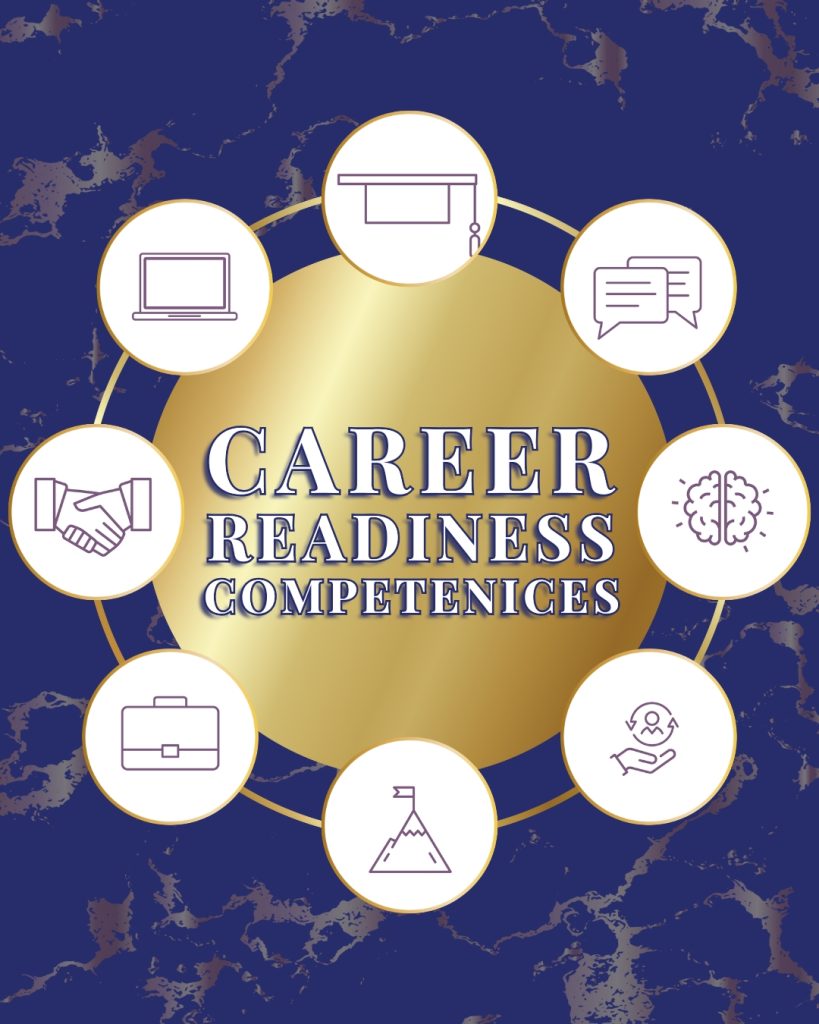What Is Career Readiness?
Career readiness is all about having the core skills and competencies that help college graduates succeed in the workplace and navigate their careers with confidence. It’s the foundation for launching a successful professional journey—and it’s quickly becoming the new career currency.
The National Association of Colleges and Employers (NACE) has identified eight Career Readiness Competencies that are closely tied to college student career success. For students and recent grads, these competencies provide a roadmap for entering the workforce with confidence and building a strong foundation for long-term success.
For colleges and universities, career readiness offers a helpful framework for shaping both academic and extracurricular experiences. For employers, it’s a valuable tool for identifying and developing talent through internships and early career opportunities.
Read on for definitions and example behaviors for each of the competencies!
 |
1. Career & Self-DevelopmentCareer readiness starts with you. This competency is all about taking ownership of your personal and professional growth—being proactive in learning, recognizing your strengths (and areas where you can improve), and seeking out opportunities that help you move forward. |
It’s also about building relationships and making thoughtful career moves, whether that’s setting goals, asking for feedback, or networking with people who can support your journey.
What does this look like in action?
- Knowing your strengths—and being honest about where you want to grow
- Seeking out feedback and using it to keep improving
- Setting career goals and creating a plan to reach them
- Advocating for yourself (and others) in a professional setting
- Being curious and open to new learning opportunities
- Taking on roles or responsibilities that help you level up
- Building and maintaining relationships that support your career
- Participating in training, workshops, or additional education that align with your goals
 |
CommunicationNo matter the industry, strong communication skills are essential. This competency is all about your ability to share ideas, information, and perspectives clearly and effectively—whether you’re speaking, writing, or using body language. It’s also about how well you listen, ask questions, and adjust your message based on your audience. |
Whether you’re collaborating with teammates, emailing a supervisor, or presenting to a group, effective communication helps you build relationships, solve problems, and get things done.
What does this look like in action?
- Communicating clearly—whether it’s face-to-face, in writing, or through body language
- Listening actively and using persuasion when appropriate
- Being thoughtful about how you organize and deliver your message
- Tailoring your communication style to different audiences, including those with diverse backgrounds and needs
- Asking smart, relevant questions to get the information you need
- Letting others know when you need help or clarification
 |
Critical ThinkingCritical thinking is the skill that helps you make informed decisions, solve problems, and respond to challenges with confidence. It means looking at the big picture, gathering information from different sources, and thinking through situations with logic, fairness, and awareness of your own perspective. |
This competency is especially valuable in fast-paced or high-stakes environments—when there’s no clear answer, critical thinkers help figure out the next right step.
What does this look like in action?
- Making thoughtful decisions using inclusive, fair-minded reasoning
- Pulling in information and ideas from a wide range of people and sources
- Anticipating needs and prioritizing what to do next
- Understanding and interpreting data while being mindful of your own biases
- Explaining your reasoning clearly, especially when others may have different perspectives
- Staying focused and juggling multiple tasks in a fast-moving environment
 |
Equity & InclusionEquity and inclusion are about more than just awareness—they’re about action. This competency involves recognizing and valuing diverse backgrounds, cultures, and identities, and working to create inclusive spaces where everyone feels respected, heard, and empowered. It also means actively challenging unfair systems and standing up for equity and justice. |
Professionals who demonstrate equity and inclusion are open to learning, engage in conversations across differences, and seek out opportunities to grow their cultural understanding—all while working to remove barriers for others.
What does this look like in action?
- Welcoming feedback from a variety of cultural perspectives to make inclusive decisions
- Taking part in efforts that promote equity, justice, and systemic change
- Advocating for fair treatment and opportunities for historically marginalized groups
- Seeking experiences that broaden your cultural knowledge and personal growth
- Staying open to new perspectives and ways of thinking
- Identifying and addressing systems of bias or inequity—whether individual or structural
- Adapting your approach to support people from different backgrounds
- Acknowledging and working to dismantle privilege where it creates barriers
 |
LeadershipLeadership is about using your strengths (and your team’s strengths) to move toward a common goal. Whether you’re leading a group project, managing a team, or simply setting a positive example, strong leaders bring vision, motivation, and accountability to the table. |
This competency is about inspiring others, making thoughtful decisions, and confidently guiding projects from start to finish, all while staying open to feedback and new ideas.
What does this look like in action?
- Encouraging and motivating others around a shared goal or vision
- Seeking out different perspectives to inform your leadership approach
- Thinking creatively and trying new strategies to solve problems
- Leading by example with confidence, positivity, and integrity
- Building trust and encouraging others to reach their potential
- Managing projects from planning to completion and reflecting on what worked (and what didn’t)
 |
ProfessionalismProfessionalism is all about showing up in presence and in attitude. It means understanding that different workplaces have different expectations and adapting your behavior to meet those expectations with integrity, accountability, and a commitment to quality. |
From being dependable and detail-oriented to aligning your actions with your values and goals, professionalism helps you build trust, deliver great work, and make a positive impact in any role.
What does this look like in action?
- Acting with integrity and accountability to yourself, your team, and your organization
- Maintaining a positive personal brand that aligns with the organization’s and your personal career values
- Being on time, prepared, and fully present
- Following through consistently on responsibilities and commitments
- Managing your time and tasks to meet (or exceed!) expectations
- Producing high-quality work with strong attention to detail
- Taking pride in your work and aiming to do your best every time
 |
TeamworkTeamwork is all about working well with others to reach shared goals. Whether you’re collaborating on a group project, participating in a meeting, or navigating workplace dynamics, strong teamwork skills help you build positive relationships, contribute meaningfully, and adapt to different people and situations. |
It’s also about appreciating different perspectives, managing conflict respectfully, and knowing when to lead, when to support, and when to compromise.
What does this look like in action?
- Actively listening and asking thoughtful questions without interrupting
- Navigating conflict with respect and resilience
- Being accountable for individual and team responsibilities and deliverables
- Using your unique strengths while appreciating the strengths of others
- Staying flexible and open to compromise
- Collaborating to achieve shared goals
- Building strong, respectful relationships with coworkers and supervisors
 |
TechnologyTechnology is key to getting things done efficiently and effectively. This competency is all about using the right tools for the job and knowing how to adapt quickly to new technologies that can improve productivity and streamline processes. |
It’s also about using technology ethically and strategically—whether that’s for decision-making, completing tasks, or reaching broader goals.
What does this look like in action?
- Staying open to learning new technologies and adapting quickly
- Using technology to make your work more efficient and productive
- Selecting the right tools for specific tasks
- Integrating technology to make better, faster decisions
- Using technology to manipulate information and achieve your strategic objectives
Taking the Next Step in Your Career Journey
Mastering these Career-Readiness Competencies is a key part of preparing for success, and higher education plays a critical role in helping you build these skills. Whether you’re in school now or looking to return, our programs are designed to help you develop the knowledge and experience needed to thrive in today’s fast-paced, dynamic job market.
Jump to a deep-dive of each of the 8 Career Readiness Competencies:
Career & Self Development
Communication
Critical Thinking
Equity & Inclusion
Leadership
Professionalism
Teamwork
Technology

